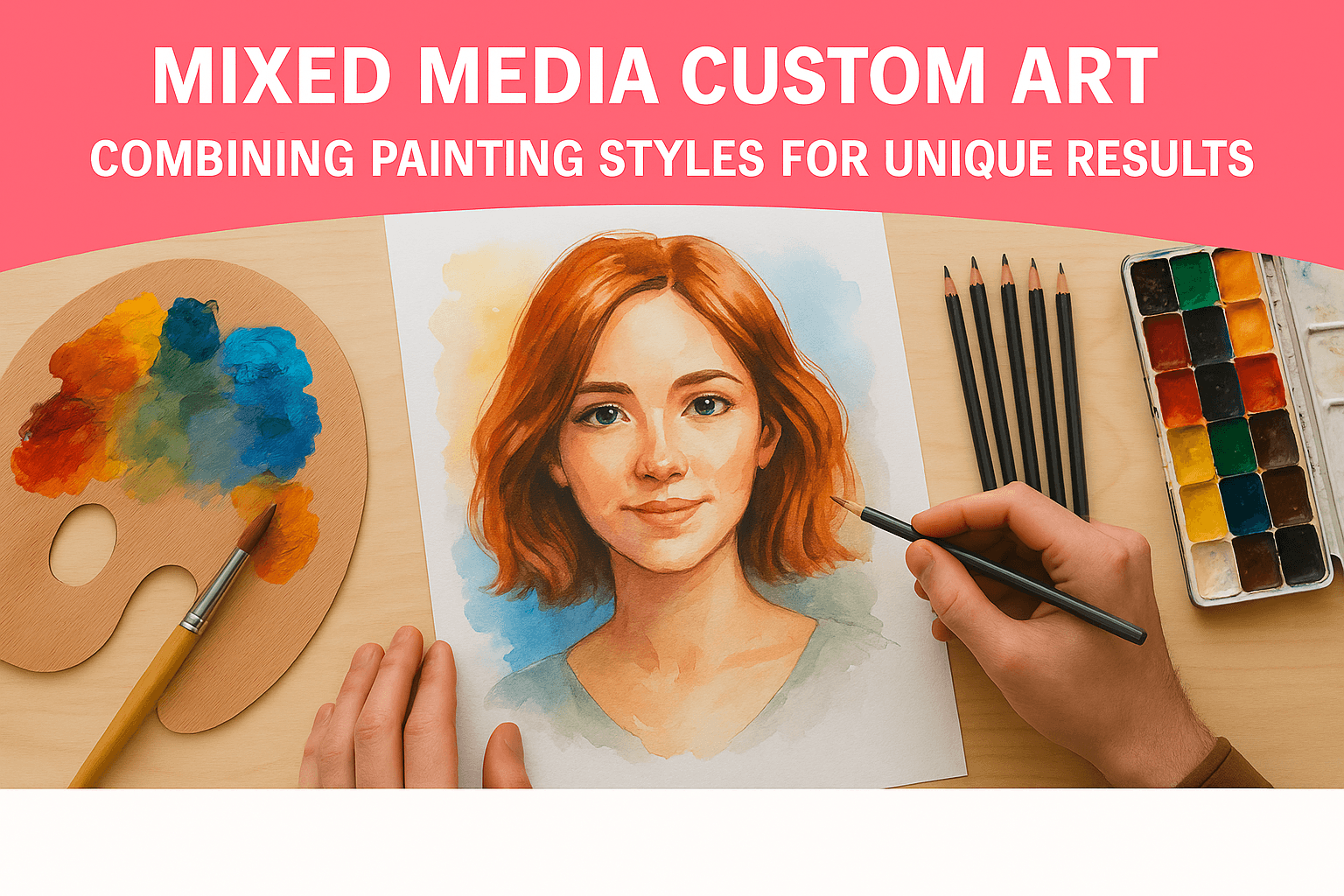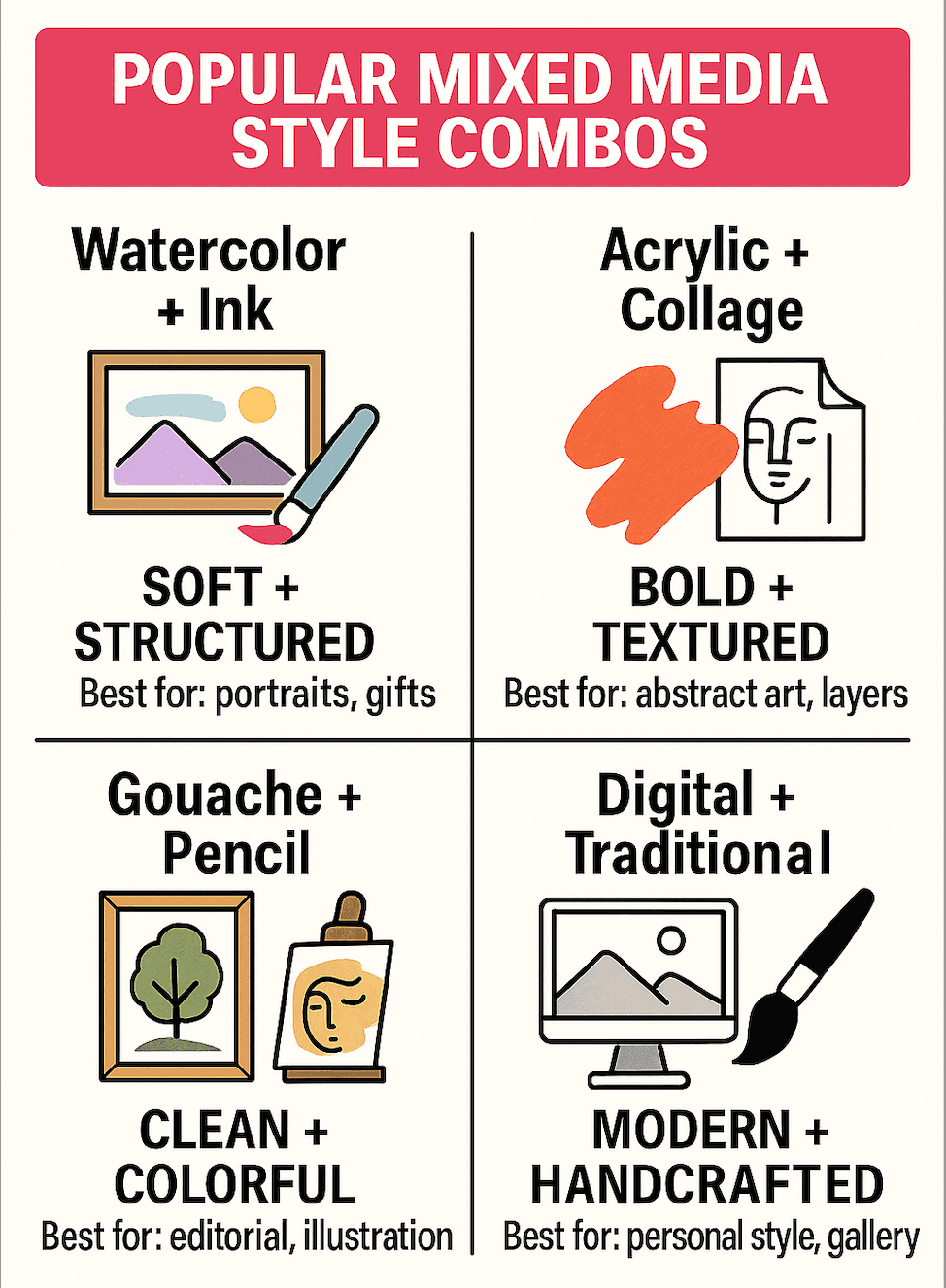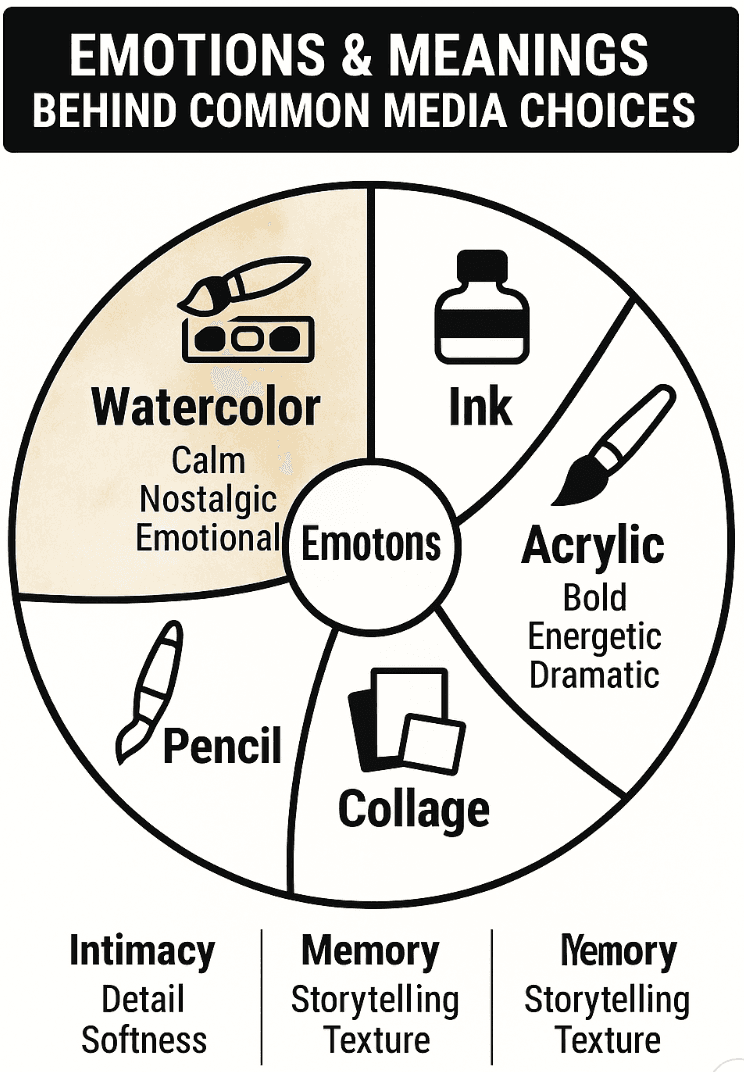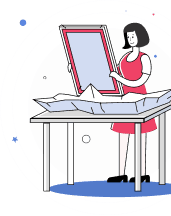Mixed Media Custom Art: Combining Painting Styles for Unique Results
Author:
GeorgeUpdated:
13.10.2025


- Key Takeaways
- What Is Mixed Media Custom Art?
- Why Combine Painting Styles?
- 1.It Lets You Break the Rules (In the Best Way)
- 2.You Get Texture, Contrast, and a Whole Lot of Wow
- 3.It Tells a Bigger, Deeper Story
- 4.Real-Life Magic
- 1.
- What Are Popular Painting Style Combinations?
- 5.Watercolor + Ink
- 6.Acrylic + Collage
- 7.Digital + Traditional
- 8.Gouache + Pencil
- 5.
- How Artists Approach Mixed Media Projects
- 9.1. Layering and Planning Techniques
- 10.2. Trial and Error: Embracing the Unpredictable
- 11.3. Balancing Composition, Texture, and Color
- 9.
- Custom Mixed Media Art: Telling a Personal Story
- 12.Symbolizing Emotions, Memories, or Dualities
- 13.Ideas for Personalized Pieces
- 14.Working With an Artist to Create Something Meaningful
- 12.
- 4 Tips for Creating Your Own Mixed Media Art
- 15.Tip 1: Start Simple With the Right Tools and Materials
- 16.Tip 2: Don’t Overthink It - Let the Process Evolve
- 17.Tip 3: Make Experimentation Part of the Art
- 18.Tip 4: Know When to Stop - When It Feels Right
- 15.
Ever look at a painting and think, “Wow, I’ve never seen anything like that before”? That’s often the power of mixed media art - where artists combine different painting styles to create something totally new.
The problem? A lot of art can start to look the same. Traditional paintings follow certain rules, and sometimes that can feel a little... predictable.
But what happens when you break those rules? Mix watercolor with ink. Layer acrylic over pencil. Blend digital touches with hand-drawn strokes. Suddenly, a painting becomes more than just a picture - it tells a story in a way that’s bold, textured, and completely original.
As artist Ashley Longshore once said,
“I am obsessed with mixing mediums because the possibilities are endless. I get to create my own world.”
This is what mixed media custom art is all about - building a piece of art that’s as unique as the person it’s made for.
Key Takeaways
Mixed media art combines different materials and painting styles to create layered, expressive artwork
It allows for greater creative freedom, texture, and emotional depth compared to using a single medium
Popular style combos include watercolor + ink, acrylic + collage, digital + traditional, and gouache + pencil
Artists use layering, experimentation, and balance to bring each mixed media piece to life
Custom mixed media art is deeply personal—perfect for telling stories, celebrating milestones, or capturing memories
Clients can collaborate with artists to include meaningful elements and create one-of-a-kind artwork
Beginners can start with simple tools and materials—no formal training needed
The process is just as important as the result: trust your instincts, experiment, and enjoy the creativity
What Is Mixed Media Custom Art?
Mixed media art is when an artist uses more than one kind of material or painting style in a single piece. For example, they might mix watercolor with pen, or add fabric and paper to a painted canvas. It’s all about blending different tools and techniques to create something that stands out.
Custom art means the piece is made just for someone - not mass produced or copied. It’s often based on a person’s idea, memory, favorite colors, or even a special photo. The artist creates it with that one person in mind, so no two pieces are the same. Here is the guide you can check out on how to choose the best painting style for your custom painting.
When you combine mixed media with custom art, you get something truly personal and creative. Artists might use soft watercolors to show emotion, then add sharp ink lines to bring out detail. Or they might layer bold acrylics with soft pencil sketches to tell a deeper story. Every choice - color, texture, style - is made to reflect the client’s vision, personality, or moment they want to remember.
It’s more than just art - it’s a one-of-a-kind piece with meaning.

Why Combine Painting Styles?
Combining painting styles is like mixing flavors in cooking - sure, each ingredient is great on its own, but put them together the right way, and something unforgettable happens. Artists use mixed media to push creative limits, add emotional layers, and craft artwork that feels alive. It’s not just about technique - it’s about telling a story in a way that’s bold, textured, and deeply personal.
Here’s why so many artists (and art lovers) are drawn to mixing styles.
It Lets You Break the Rules (In the Best Way)
Most traditional art sticks to one medium. Watercolor goes here. Ink goes there. Everything has its box. But mixed media says - why not both? By blending different painting styles, artists can step outside those limits and explore new possibilities.
Want to splash loose watercolor across the page and then define it with bold ink lines? Go for it. Prefer layering messy acrylic strokes over delicate pencil sketches? That contrast is what makes it special. Mixed media is about freedom - creative, expressive, rule-breaking freedom.
You Get Texture, Contrast, and a Whole Lot of Wow
When you mix painting styles, you’re not just adding color - you’re adding feel. Imagine the softness of watercolor fading into rough acrylic brushwork. Or a glossy layer of gel medium sitting on top of matte gouache. These textures aren’t just pretty - they pull your eyes across the canvas and make the artwork more dynamic.
Contrast - between light and dark, soft and sharp, smooth and rough - helps the important parts of the piece stand out. It adds drama, movement, and visual interest that a single medium just can’t offer on its own.
It Tells a Bigger, Deeper Story
Each painting style carries its own emotion. Watercolor can feel dreamy, nostalgic, or soft. Ink adds clarity and confidence. Acrylic might bring energy, chaos, or boldness. When artists combine these voices, they tell stories with more depth.
A mixed media piece doesn’t just show a person, place, or feeling - it layers it. Think of it like a song with harmony instead of a single melody. Whether the art is custom-made for a person, a memory, or a moment, the combination of styles lets it speak on more than one level.
Real-Life Magic
- A wedding painting starts with soft washes of watercolor to capture the emotion of the day, then adds crisp pen lines to define the couple’s features - balancing feeling with detail.
- A pet portrait uses textured acrylics to create a vibrant, energetic background, while colored pencil brings out the shine in their eyes and the softness of their fur.
- A travel-inspired piece blends bold gouache landscapes with collaged map pieces and handwritten quotes from the trip - turning a simple painting into a deeply personal keepsake.
These aren’t just paintings. They’re layered experiences. And the beauty of mixed media is that there’s no one “right” way to do it - only the way that feels right for the story you're telling.
What Are Popular Painting Style Combinations?
One of the best things about mixed media art is that there are so many ways to combine styles. Some pairings are subtle, while others are bold and unexpected. Each combo creates a different mood, texture, and overall vibe - so whether someone wants something soft and emotional or bold and graphic, there's a blend that fits.
Here are a few of the most popular and versatile painting style combinations artists love to work with,
Watercolor + Ink
This is a classic combo for a reason. Watercolor brings softness, light, and flowy color washes, while ink adds structure, depth, and crisp outlines. When used together, they create a beautiful balance between loose and controlled.
Artists often use this mix for portraits, botanical illustrations, or fantasy scenes - anywhere you want both mood and detail. The ink gives form to the fluid watercolor, making the piece feel alive but grounded.
Acrylic + Collage
Acrylic is bold, textured, and fast-drying - perfect for layering. Collage elements like paper, fabric, magazine cutouts, or even text can be added in between paint layers to give extra personality and dimension.
This combo is perfect for abstract or contemporary pieces where artists want to explore themes, tell a story, or make a statement. The texture of the acrylics mixed with the unpredictability of collage makes each piece feel spontaneous and raw - in a good way.
Digital + Traditional
In today’s art world, blending traditional hand-drawn or painted work with digital tools is becoming more and more common. An artist might start with a pencil sketch or watercolor base, then scan it and add color, detail, or effects digitally.
This hybrid method gives the final piece a modern, clean finish while keeping the warmth and character of traditional media. It’s great for custom illustrations, branding, or prints where flexibility and polish are key. You can check the article on why an oil painting is best for your custom painting.
Gouache + Pencil
Gouache offers rich, matte color that feels solid and smooth - kind of like the lovechild of watercolor and acrylic. Pair that with pencil (either graphite or colored), and you get crisp lines layered over solid color blocks.
This style combo is a favorite in editorial art, children’s books, and stylized portraits. It’s perfect for detailed work with a clean, graphic feel, while still feeling handcrafted and expressive.
Want something expressive, personal, and visually layered? These combos are just the start - mixed media gives artists endless tools to make your story come to life in ways that are anything but ordinary.

How Artists Approach Mixed Media Projects
Creating mixed media art isn’t just about grabbing a bunch of tools and going wild (well, not always). There’s often thought, layering, and a bit of improvisation involved. Every artist has their own process, but most mixed media pieces come to life through a mix of planning, experimentation, and a good eye for balance.
Here’s how artists usually approach the creative chaos of mixing styles.
1. Layering and Planning Techniques
Before even picking up a brush or pen, many artists start by thinking through the order of operations. Some materials need to go down first - like watercolor washes or light pencil sketches - because once you’ve added ink or acrylic, there’s no going back. Planning helps avoid smudges, warping, or layering issues.
Artists often work in stages: background first, then texture, then detail. For example, they might paint a soft wash of color, let it dry, then add pencil shading or ink outlines on top. This approach keeps the materials from fighting each other and ensures each layer adds to the overall design.
2. Trial and Error: Embracing the Unpredictable
Even with a plan, mixed media is full of surprises - and that’s part of the fun. Watercolor might bleed in an unexpected way. Acrylic might dry faster than expected. That’s where the magic often happens.
Artists learn to work with the unpredictability instead of against it. Smudges become texture. Unexpected color blends spark new ideas. Some of the most beautiful moments in mixed media art happen by accident. It’s less about perfection and more about process.
3. Balancing Composition, Texture, and Color
Because mixed media includes so many different elements, keeping a piece visually balanced is key. Artists are constantly thinking about how textures interact, how colors complement or contrast, and where the eye is drawn across the canvas.
Too much texture in one spot can overwhelm the rest. Too many bright colors might compete instead of working together. So it becomes a game of editing and adjusting - adding ink lines to anchor a soft background, or layering white space to let bold areas breathe.
The goal is harmony - even in the chaos. When it's done right, every element feels like it belongs, even if the process was a little messy along the way.
Custom Mixed Media Art: Telling a Personal Story
One of the most powerful things about mixed media is its ability to tell stories - real ones. When an artist combines different styles or materials, they’re not just showing a subject, they’re expressing a feeling, a moment, or even a piece of someone’s personality.
This is where custom mixed media art really shines. It’s personal, emotional, and completely one-of-a-kind.
Symbolizing Emotions, Memories, or Dualities
Mixed media gives artists the tools to capture more than just how something looks - it can show how it feels. By combining soft and hard textures, calm colors with bold strokes, or loose washes with structured lines, artists can reflect emotional contrast within a single piece.
Think about watercolor for calmness layered with sharp ink lines to represent clarity. Or textured collage pieces layered under acrylics to symbolize a life built from different moments. These contrasts help tell stories with depth and emotion - making the art more than just decorative.
Ideas for Personalized Pieces
Here are a few meaningful ways people use custom mixed media art to capture memories, people, or important moments:
Occasion or Theme | Style Combo | Why It Works |
Wedding or Anniversary | Watercolor + Ink | Soft washes for romance, ink for fine details - captures the emotion and elegance |
Pet Portrait | Acrylic + Colored Pencil | Bold background energy + delicate fur texture for personality and warmth |
Baby or Birthday Gift | Gouache + Collage | Bright colors + playful paper layers = a fun, heartfelt keepsake |
Travel Memory | Watercolor + Map Collage + Handwritten Text | Evokes place and feeling; turns a moment into a layered, visual journal |
Graduation or Retirement | Pencil + Digital Finish | Clean sketch style + polished touches for a modern, reflective look |
These pieces often become lasting gifts - things people keep, frame, and pass down. Because they don’t just show what happened. They feel like it.
Working With an Artist to Create Something Meaningful
Custom mixed media is often built on collaboration. Most artists begin by asking simple but important questions: What’s the story? Who’s it for? What should it feel like?
From there, they choose materials that match that energy. Maybe someone wants to honor a grandparent with a piece that feels vintage and layered - so the artist uses muted tones, old photos, handwritten recipes, and soft pencil shading. Or maybe a client wants something bold and colorful to celebrate a new chapter in life - acrylics, collage, and digital layering might come into play.
Some clients even provide their own personal items - letters, maps, fabric, or quotes - that become part of the piece.
The result? Artwork that isn’t just about someone - it feels like them.
4 Tips for Creating Your Own Mixed Media Art
Thinking about trying mixed media art for yourself? Good news: there are no rules - just some helpful starting points. Whether you’re brand new to art or looking to switch things up, mixed media is all about exploration, layering, and finding what works for you. Here are some tips to help you dive in without feeling overwhelmed.
Tip 1: Start Simple With the Right Tools and Materials
You don’t need a studio full of supplies to begin. Start with a few basic materials,
- Watercolor paints or gouache
- Ink pens or fine liners
- Acrylic paints
- Colored pencils or graphite
- Paper scraps, fabric, or old book pages for collage
- Mixed media paper (sturdy enough for wet + dry materials)
- Brushes, glue stick, and maybe some washi tape for fun
Pick a few things you’re curious about and experiment with how they layer and react to each other.
Tip 2: Don’t Overthink It - Let the Process Evolve
Mixed media isn’t about having a perfect plan. In fact, some of the best pieces come from just starting with a color, texture, or mood and seeing where it goes. Begin with one layer - maybe a watercolor wash or a pencil sketch - then build from there. Trust your instincts, and don’t worry about “messing up.” There’s always a way to add, cover, or turn something unexpected into something beautiful.
Tip 3: Make Experimentation Part of the Art
Try things just to see what happens. What if you drew over wet watercolor with ink? What if you glued down a bit of fabric and painted over it? Not everything will work - and that’s okay. Each piece teaches you something new. Keep a sketchbook or “test paper” nearby where you can try out techniques before adding them to your main piece.
Mixed media is as much about curiosity as it is about technique.
Tip 4: Know When to Stop - When It Feels Right
This might be the trickiest part. With so many layers and options, it’s easy to keep adding... and adding. But a good habit is to pause and ask: Does this feel finished? Does it say what I want it to say?
Sometimes, less is more. Trust your gut. If you love how it looks, even if it’s imperfect - that’s probably the moment to stop. Remember, art doesn’t have to be “done” by someone else’s standards. It just has to feel right to you.
Whether your goal is to create for yourself, gift someone something meaningful, or start offering custom pieces, mixed media is a creative playground where anything is possible. Start messy, stay curious, and let the layers tell your story.
Conclusion
Mixed media art is more than just a style - it’s a way of telling stories that feel layered, emotional, and real. By combining painting styles, artists can express dualities like calm and chaos, soft and strong, past and present. Whether it’s a custom gift, a personal keepsake, or just a creative outlet, mixed media opens the door to artwork that’s completely unique.
And the best part? There’s no one right way to do it. You can start simple, experiment boldly, and let each piece evolve naturally. Every brushstroke, texture, or material adds something to the story.
As artist Amy Sherald puts it,
“My work is about seeing and being seen. I use layers - literal and metaphorical - to express identity, history, and presence.”
Whether you're commissioning or creating, mixed media gives you the tools to turn feelings into form - and make art that truly means something.
Frequently Asked Questions
What is mixed media art in painting?
Mixed media art is when an artist uses more than one type of material or technique in a single piece. For example, combining watercolor with ink, or layering acrylic paint with collage elements. The goal is to create depth, contrast, and visual interest by blending styles.
Why do artists combine different painting styles?
Combining painting styles allows artists to explore texture, emotion, and storytelling in more complex ways. It helps them create artwork that feels layered and expressive—where each style contributes something unique to the overall mood or message.
Can I create mixed media art without formal training?
Absolutely. Mixed media is one of the most beginner-friendly art forms because it encourages experimentation. You don’t need formal training—just curiosity and a willingness to play with materials. There’s no “wrong” way to layer or combine styles.
Can I request a custom mixed media artwork from an artist?
Yes! Many artists offer custom mixed media commissions. You can work with them to choose colors, themes, and even provide personal items (like quotes, photos, or textures) to include. The result is a one-of-a-kind piece that tells your story.
What’s the difference between mixed media and multimedia art?
Mixed media refers to combining different art materials (like paint, ink, collage) in a single artwork. Multimedia art often involves digital elements, sound, video, or performance—beyond just physical materials. Both blend mediums, but mixed media is typically more focused on visual, tangible art.
George, CEO of Photo2painting, is a passionate art lover and entrepreneur. He founded Photo2painting.com from scratch, inspired by his artist friends. As the company's CMO, he manages content and marketing.
Excellent Customer Reviews





































































































































































